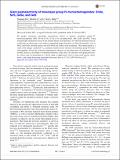| dc.contributor.author | Fei, Ruixiang | |
| dc.contributor.author | Li, Wenbin | |
| dc.contributor.author | Li, Ju | |
| dc.contributor.author | Yang, Li | |
| dc.date.accessioned | 2016-11-03T20:49:32Z | |
| dc.date.available | 2016-11-03T20:49:32Z | |
| dc.date.issued | 2015-10 | |
| dc.date.submitted | 2015-07 | |
| dc.identifier.issn | 0003-6951 | |
| dc.identifier.issn | 1077-3118 | |
| dc.identifier.uri | http://hdl.handle.net/1721.1/105190 | |
| dc.description.abstract | We predict enormous, anisotropic piezoelectric effects in intrinsic monolayer group IV monochalcogenides (MX, M=Sn or Ge, X=Se or S), including SnSe, SnS, GeSe, and GeS. Using first-principle simulations based on the modern theory of polarization, we find that their piezoelectric coefficients are about one to two orders of magnitude larger than those of other 2D materials, such as MoS[subscript 2] and GaSe, and bulk quartz and AlN which are widely used in industry. This enhancement is a result of the unique “puckered” C[subscript 2v] symmetry and electronic structure of monolayer group IV monochalcogenides. Given the achieved experimental advances in the fabrication of monolayers, their flexible character, and ability to withstand enormous strain, these 2D structures with giant piezoelectric effects may be promising for a broad range of applications such as nano-sized sensors, piezotronics, and energy harvesting in portable electronic devices. | en_US |
| dc.description.sponsorship | National Science Foundation (U.S.) (Grant DMR-1410636 and DMR-1120901) | en_US |
| dc.language.iso | en_US | |
| dc.publisher | American Institute of Physics (AIP) | en_US |
| dc.relation.isversionof | http://dx.doi.org/10.1063/1.4934750 | en_US |
| dc.rights | Article is made available in accordance with the publisher's policy and may be subject to US copyright law. Please refer to the publisher's site for terms of use. | en_US |
| dc.source | MIT web domain | en_US |
| dc.title | Giant piezoelectricity of monolayer group IV monochalcogenides: SnSe, SnS, GeSe, and GeS | en_US |
| dc.type | Article | en_US |
| dc.identifier.citation | Fei, Ruixiang et al. “Giant Piezoelectricity of Monolayer Group IV Monochalcogenides: SnSe, SnS, GeSe, and GeS.” Applied Physics Letters 107.17 (2015): 173104. © 2015 AIP Publishing LLC | en_US |
| dc.contributor.department | Massachusetts Institute of Technology. Department of Nuclear Science and Engineering | en_US |
| dc.contributor.department | Massachusetts Institute of Technology. Research Laboratory of Electronics | en_US |
| dc.contributor.mitauthor | Li, Wenbin | |
| dc.contributor.mitauthor | Li, Ju | |
| dc.relation.journal | Applied Physics Letters | en_US |
| dc.eprint.version | Final published version | en_US |
| dc.type.uri | http://purl.org/eprint/type/JournalArticle | en_US |
| eprint.status | http://purl.org/eprint/status/PeerReviewed | en_US |
| dspace.orderedauthors | Fei, Ruixiang; Li, Wenbin; Li, Ju; Yang, Li | en_US |
| dspace.embargo.terms | N | en_US |
| dc.identifier.orcid | https://orcid.org/0000-0002-7841-8058 | |
| mit.license | PUBLISHER_POLICY | en_US |
| mit.metadata.status | Complete | |
